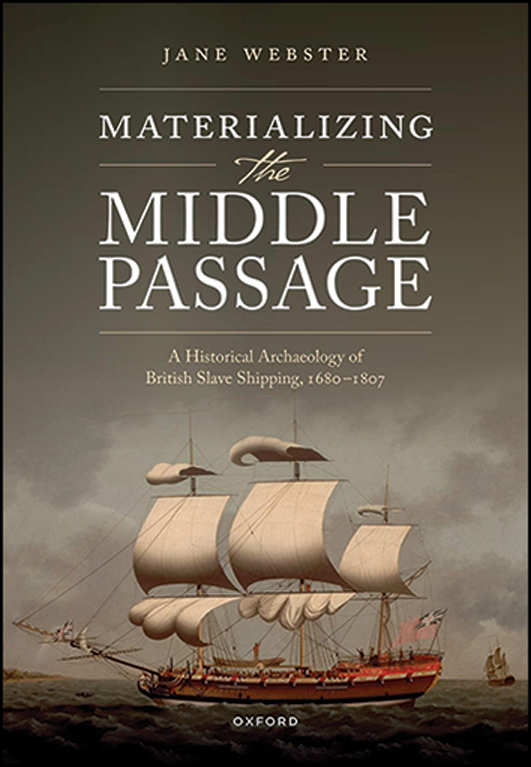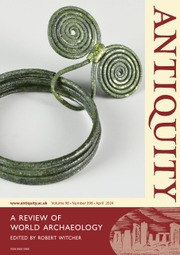
In the concluding chapter of Materializing the Middle Passage, Jane Webster asserts that “it is possible to materialize many aspects of the Middle Passage” that millions of African captives endured as one section of the trade route that took enslaved Africans to the Americas and West Indies; however, she then acknowledges that “in that endeavour, I have needed to draw primarily on the written testimonies of the sailors who crewed the ships” (p.439). The result of the tension captured in those sentences—between Webster’s interest in material culture and her necessary reliance on textual sources—is a unique and fascinating book about the trafficking of enslaved Africans on British ships. Materializing the Middle Passage combines an archaeologist’s focus on goods, crafts and built environments with (mostly) the textual sources of historians, although Webster makes great use of art and material artefacts wherever possible. “There are other ways to excavate the slave ship,” Webster insists, than relying on the discovery and exhumation of shipwrecks (p.2). Explicitly embracing historical archaeology, Materializing the Middle Passage seeks to “marry words and things” (p.5).
Webster brings together the material and textual remains of the British Atlantic slave trade not only through inter-disciplinary methods but also relentless research. To uncover the shipboard environments and experiences of the Atlantic crossing, Webster investigates the excavation records of all known slave-ship wrecks, artworks by eyewitnesses depicting slave ships, testimonies from UK parliamentary investigations of the slave trade, and surviving journals and autobiographies from crew members and captives alike. Taking a capacious view of the Middle Passage, Webster also looks beyond the seaborne voyages of captives and sailors from Africa to the Americas to investigate the commodities that Europeans delivered to West African societies in exchange for captives, the changing African representations of Europeans and their ships in art and iconography, and memories of the ocean crossing in the communities that enslaved people created in the Americas. It is a staggering research effort, and I imagine readers from any discipline will be exposed to new material. As a historian of the slave trade, I found most of Webster’s textual sources familiar, but I had encountered only a fraction of the art, shipwrecks and material remains upon which she draws. Even familiar sources were interpreted from a fresh and intriguing perspective.
On the surface, Materializing the Middle Passage is about ‘things’ but the book is really about mindsets. Webster deploys the material record and textual evidence about the slave trade’s environments and conditions to explore the worldviews of both the traders (European and African) and those people they traded. Through coats of arms and displays of the spoils of the traffic, Webster shows that Europeans made “both a financial and an emotional investment in the slave trade” (p.8). Likewise, the African coastal elites who sold people to Europeans, brought not just European luxury goods (and Asian goods delivered by Europeans) into their lives and self-presentation, but also incorporated slave-ship motifs into ancestor shrines, European ships’ figureheads into artistic representations of water deities, and European ship carpentry techniques into their arts and construction.
While giving attention to such European and African traders, however, Webster’s primary focus is on the captives. The arguments articulated in the book’s introductory and concluding chapters consider the experiences of enslaved people in the ocean crossing—the conditions they endured, the limited materials they carried and how they began to reimagine their identities through the experience. Explicitly aligning her work with historians such as Stephanie Smallwood (Reference Smallwood2007) and Alexander Byrd (Reference Byrd2006), Webster “positions the slave ship as a site in which pre-existing African identities were neither fully retained nor entirely lost” (p.12). While citing Michael Gomez (Reference Gomez1998), Judith Carney (Reference Carney2001) and others who assert strong African cultural continuities in diaspora, Webster complicates Gomez’s idea that “home remained Africa for the African-born,” arguing instead for Africans in the Americas developing a “saltwater identity in the diaspora” (pp.10–11). Webster notes that Africans were stripped of clothing and possessions for the crossing, but she shows that some retained strings of beads or other limited adornments that ship crews perceived as no threat to ship hygiene or security, which helps explain how cowries and African-made beads surface from some New World burial sites. Likewise, Webster uses detailed attention to slave ships’ built environments and daily routines to expose how captives’ involvement in food preparation, compulsory dance (to keep limber and healthy for sale) and sanctioned pastimes, with game pieces or beads, facilitated some cultural retention and creativity even in the harrowing conditions of the slave trade’s floating prisons. The author presents compelling evidence of Africanisms in the Americas, rejecting the idea that African culture was annihilated in the Middle Passage, but she asserts something more nuanced than mere cultural retention. Webster interprets the material record to show that enslaved people reformulated identities through the journey—drawing on remembered pasts, the minimal materials carried with them and new experiences of seaborne travel, encounters with sailors, fellow captives and the ships themselves. The result was a “saltwater identity,” drawn not just from Africa but also forged in the ocean crossing.
While Webster’s arguments about the Atlantic crossing are compelling and supported with robust research, it is worth noting that the aims of the book’s individual chapters are substantially broader than the main arguments advanced in the Introduction and Conclusion. In a sense, the book is part monograph and part catalogue. The introductory chapter and Chapters 9 to 12 focus squarely on the shipboard experiences of captives, their identity transformation and their forging of shipmates’ bonds that lasted in the Americas. The other chapters have distinct aims and a broader scope. Chapter 2 surveys the historical literature on the British slave trade, while Chapters 3, 4 and 5 catalogue the sources—more like a summary of what is available for study rather than an interpretation. Chapter 3 describes some available eyewitness accounts of slave ships; Chapter 4 describes the excavation of each known wreck of a slave ship; while Chapter 5 compiles the art and textual sources available for reconstructing the shipboard environment. Chapters 6, 7 and 8 are more interpretive (and are fascinating) but take a broad view of the ‘Middle Passage’. Rather than focusing on the journeys of enslaved Africans across the Atlantic, they discuss, respectively, how societies in Atlantic Africa understood and represented slave ships and European traders, how African societies incorporated the goods delivered by European traders, and how European societies incorporated goods from Africa that were brought home on slave ships. Webster is to be commended for the depth and range of Materializing the Middle Passage, but the structure does set up for some repetition and delays, with sources and artefacts introduced in early chapters but analysed only much later. Readers must also wait a long time after the introductory chapter, which is primarily about African identity formation in transit, to return to shipboard captives as the subjects of study in Chapters 9 to 12.
It is worth the wait, however, and all the detours are interesting. Materializing the Middle Passage brings together research on art history, maritime archaeology and history from all around the Atlantic, for fresh insights in a well-established field. Scholars approaching the book from any of these perspectives and any geographic corner of the Atlantic are sure to find much that is new and stimulating in this wide-ranging, robustly researched and compellingly argued book.


